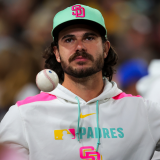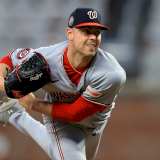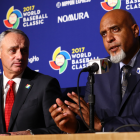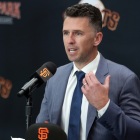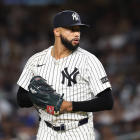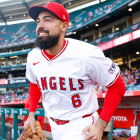
A look at the Red Sox lineup after David Ortiz and how they'll do without him
Will an improved pitching staff and team defense be enough to make up for the loss of Big Papi?

The 2016 season was David Ortiz's swan song with the Red Sox, and it was one of the most productive farewell seasons in history. Big Papi smashed 38 home runs and led baseball in doubles (48), slugging percentage (.620), and OPS (1.021). The 162 OPS+ represents the third best season of his career behind 2012 (173) and 2007 (171).
Thanks in part to Ortiz's brilliance, the Red Sox led baseball with 878 runs scored this past season, 33 more than the second place Rockies and 101 more than the next closest AL team, the Indians. Ortiz announced his plans to retire in spring training, so it wasn't a surprise. BoSox president of baseball operations Dave Dombrowski went into the offseason knowing he needed a new DH, and he came up with ... Mitch Moreland. Ouch.
There's no way to sugarcoat it, Red Sox fans: the drop off from Ortiz to Moreland is enormous. Moreland's best offensive season, 2015, is roughly equivalent to Ortiz's 14th best season. Even if you think Moreland's output will tick up in Fenway Park -- then again, it's not like he's been in a pitcher's park with the Rangers all those years -- and Ortiz couldn't have possibly repeated his 2016 season in 2017, it's still a big step down.
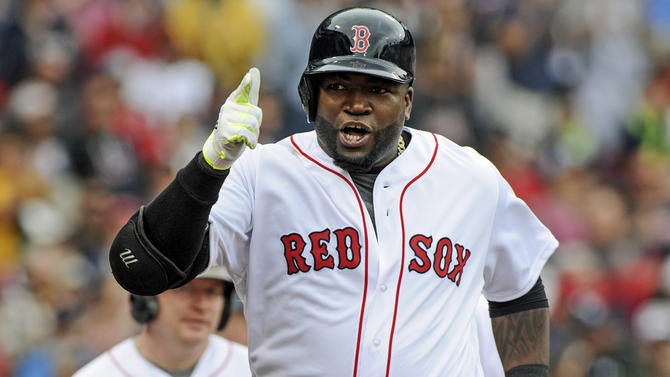
The Red Sox and Dombrowski know this. In terms of OPS, Ortiz was the most productive hitter in baseball this past season, and that by definition makes him irreplaceable. Whoever they brought in to fill the roster spot was going to be a downgrade. Would Edwin Encarnacion or Jose Bautista have been a smaller downgrade than Moreland? Of course. But they would have cost a ton more too, both in terms of dollars and years (and a draft pick).
Let's run some quick numbers here. The Red Sox scored 878 runs in 2016. That's a fact. It happened. Now let's use the Baseball Musings Lineup Analysis tool to see how many runs the Red Sox were expected to score based on their starting lineup. These were the team's leaders in plate appearances at each position in 2016:
Catcher: Sandy Leon (.310/.369/.476)
First Base: Hanley Ramirez (.286/.361/.505)
Second Base: Dustin Pedroia (.318/.376/.449)
Shortstop: Xander Bogaerts (.294/.356/.446)
Third Base: Travis Shaw (.242/.306/.421)
Left Field: Brock Holt (.255/.322/.383)
Center Field: Jackie Bradley Jr. (.267/.349/.486)
Right Field: Mookie Betts (.318/.363/.534)
Designated Hitter: David Ortiz (.315/.401/.620)
Plug those numbers into the Lineup Analysis tool and it says that lineup is expected to score 5.854 runs per game, or 948 runs across 162 games. That's a heck of a lot more than the 878 runs the Red Sox actually scored in 2016! There are three reasons that explain the big gap between actual runs scored and expected runs scored:
- The Lineup Analysis tool optimizes the lineup. The tool runs the numbers and puts each batter in the best possible lineup spot. For example, Ortiz batted cleanup most of 2016, but the tool slots him in as the No. 2 hitter, which means he gets more at-bats during the season.
- The same lineup doesn't get used 162 times. The Lineup Analysis tool assumes the same players are starting every game, and we know that's not realistic. Christian Vazquez and Blake Swihart saw time behind the plate for the Red Sox this past season. Chris Young played a bunch of left field. Aaron Hill and Yoan Moncada made appearances at the hot corner. The Lineup Analysis tool doesn't account for bench players.
- Sequencing matters! The order of events is important. A walk, a bloop, and a blast gives you a three-run home run. A blast, a bloop, and a walk gives you one run even though the same three things happened. Sometimes things don't go according to plan in real life and you wind up with fewer (or more!) runs than expected.
Based on the actual and expect run totals, the Lineup Analysis tool is off by a factor of 8.0 percent. That's not a huge error, but it's not nothing either. At least we're in the same ballpark. Had the Lineup Analysis tool spit out, say, 710 expected runs, or 1,150 expected runs, it would be a problem.
Okay, so knowing that, let's look at how the 2017 Red Sox offense compares to the 2016 Red Sox offense. Keep in mind Moreland is not the only new face. Pablo Sandoval figures to replace Shaw, who was traded to the Brewers in the Tyler Thornburg deal earlier this month, at third base. Early AL Rookie of the Year candidate Andrew Benintendi is primed to take over left field.
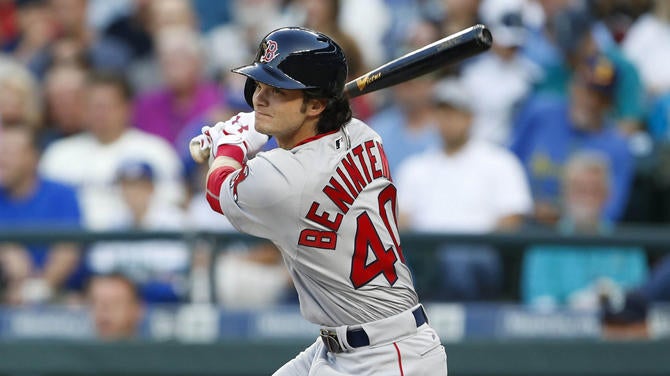
Also, we have to consider each player is not likely to repeat their 2016 performance in 2017. That's just not the way baseball works. Some players will perform better -- the Red Sox have a lot of young and exciting players who could take their game to another level -- and some will perform worse. Leon, for example, seems ripe for regression. There's nothing in his track record to suggest his 2016 performance was anything more than a 283 plate appearance fluke.
To help give us an idea of what key Red Sox players are expected to do next season, we're going to use ZiPS and Steamer projections, both of which are available at FanGraphs. I feel compelled to mention projections are not predictions. They're an estimate of the player's true talent level at this point in time. Sometimes they're wrong. Many times they're wrong! But on a macro scale, they can be shockingly accurate.
Here's what the Lineup Analysis tool tells us for the 2017 Red Sox using the two projection systems.
| ZiPS | Steamer | |
| C Sandy Leon | .246/.311/.367 | .243/.307/.358 |
| 1B Hanley Ramirez | .280/.358/.471 | .282/.352/.487 |
| 2B Dustin Pedroia | .291/.351/.408 | .289/.354/.417 |
| SS Xander Bogaerts | .288/.343/.432 | .296/.354/.447 |
| 3B Pablo Sandoval | .264/.313/.406 | .272/.326/.429 |
| LF Andrew Benintendi | .278/.341/.446 | .282/.338/.439 |
| CF Jackie Bradley Jr. | .255/.332/.443 | .261/.338/.438 |
| RF Mookie Betts | .307/.361/.504 | .310/.366/.515 |
| DH Mitch Moreland | .244/.304/.415 | .255/.320/.435 |
| Expected Runs per Game | 4.987 | 5.141 |
| Expected Runs per 162 Games | 808 | 833 |
My guess is Moreland will end up playing more first base with Hanley at DH because he's a better defender, but for the purposes of an offense-only analysis, position doesn't matter. It does in real life -- Moreland will save more runs defensively than Hanley, which will help make up for the loss of Ortiz -- but not when talking about offense and only offense.
So anyway, both projection systems expect the Red Sox to score a boatload of runs next season, even with Moreland replacing Ortiz. If we apply the 8.0 percent factor to those expected run totals -- that 8.0 percent essentially accounts for bench players and less than ideal lineup construction -- we're still looking at a lineup projected to score 748 runs (per ZiPS) and 771 runs (per Steamer) in 2017. That's plenty in this day and age.
Compared to the 2016 Red Sox, the 2017 Red Sox are expected to score fewer runs, and that should surprise no one. Losing Ortiz is a huge blow, even with healthy Sandoval and Benintendi representing upgrades over Shaw and Holt, respectively. The real question is how the 2017 Red Sox with Ortiz compare to the 2017 Red Sox without Ortiz. Both ZiPS and Steamer provided Big Papi projections:
ZiPS: .282/.368/.558 (per ZiPS guru Dan Szymborski)
Steamer: .286/.370/.527
Goodness. Even after turning 41 in November, both projection systems believe Ortiz still has enough in the tank to be a monster in 2017. That's not surprising though. Ortiz had a historically great age 40 season, so it's not unreasonable to think he could put together a historically great age 41 season. Remember, this guy has been a full-time DH for more than a decade now. He doesn't have the same wear-and-tear on his body as other 41-year-old players. I have no doubt that contributed to his 2016 excellence.
Swapping out Moreland's projections for Ortiz's projections in the Lineup Analysis tool gives us these results for the 2017 Red Sox offense:
ZiPS with Ortiz: 5.275 runs per game (855 runs per 162 games)
Steamer with Ortiz: 5.341 runs per game (865 runs per 162 games)
The Lineup Analysis tool sees the difference between Moreland and Ortiz being roughly one-quarter of a run per game, which is pretty substantial. Even applying the 8.0 percent factor, we still get 792 runs (per ZiPS) and 801 runs (per Steamer), which is really good. Only three teams (Red Sox, Rockies, Cubs) scored more than 792 runs in 2016.
Just to keep everything nice and tidy, here is a summary of our quick-and-dirty 2017 Red Sox offense analysis using ZiPS and Steamer projections, the Lineup Analysis tool, and that 8.0 percent factor:
| ZiPS | Steamer | |
| With Ortiz | 792 runs | 801 runs |
| Without Ortiz | 748 runs | 771 runs |
The caveats are obvious. First and foremost, projections are not exact. Who's to say Big Papi wouldn't have fallen off a cliff at age 41 in 2017? Alex Rodriguez went from 33 home runs and a 129 OPS+ at age 39 in 2015 to nine homers and a 58 OPS+ in 2016. When it goes, it often goes quickly. Secondly, playing time and sequencing matter, as does lineup construction. Predicting the future is basically impossible. Baseball would be boring if it weren't.
Now, here's the thing: the Red Sox are likely to score fewer runs in 2017 without Ortiz, but other aspects of the team have improved. Chris Sale is an enormous upgrade over Clay Buchholz. A full season of Drew Pomeranz over the likes of Joe Kelly and Sean O'Sullivan will help too. Moreland is a better first base defender than Hanley. Benintendi is a better outfielder than Holt. Carson Smith is expect back at some point.
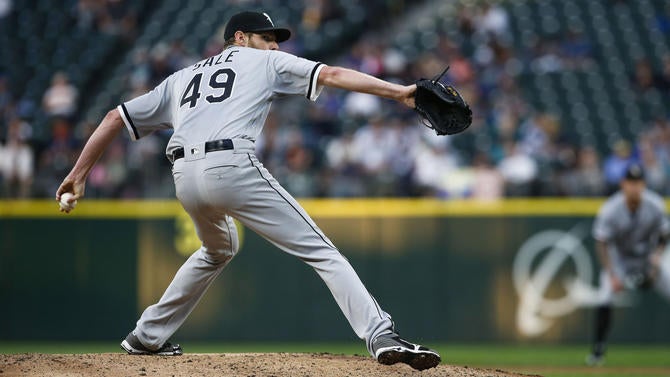
The loss of Big Papi takes a bite out of the Red Sox offense. It won't be as scary as it was this past season without him. Ortiz is one of those guys you dread facing in a big spot. He changed the way opposing pitchers pitched and opposing managers managed just by standing in the on-deck circle. The Red Sox are losing that x-factor, which may not be quantifiable, but certainly exists.
Upgrades made elsewhere on the roster, most notably in the rotation but also in the bullpen and defensively, improve the Red Sox in other phases of the game and will help the club compensate for the loss of Ortiz. They may not score as many runs next year, but they also figure to allow fewer runs as well. Moreland is a less than inspiring choice to replace Big Papi in the lineup. He really is. Collectively though, the entire roster should help make up for what they're losing with Ortiz's retirement.


